Comparative Study: Paternity Leave Policies in America and Europe
VerifiedAdded on 2023/04/22
|6
|1575
|131
Essay
AI Summary
This essay provides a comparative analysis of paternity leave policies in the United States and various European countries. It highlights the disparities in leave duration, pay, and governmental support for parental leave. The essay argues that the US lags behind European nations in providing adequate paternity leave, impacting gender equality and child development. It references the Family and Medical Leave Act (FMLA) in the US and contrasts it with the more generous and flexible policies in countries like Finland, Norway, Hungary, Slovenia, Lithuania, Iceland, and Sweden. The author emphasizes the benefits of paid paternity leave, including shared parental responsibilities, improved maternal health, and enhanced child well-being. The essay concludes by advocating for more flexible and supportive paternity leave policies in the US, including increased wage percentages during leave and subsidized medical expenses for non-employed parents, to promote gender-balanced parenting and positive child development outcomes. Desklib offers a wealth of similar essays and study resources for students.
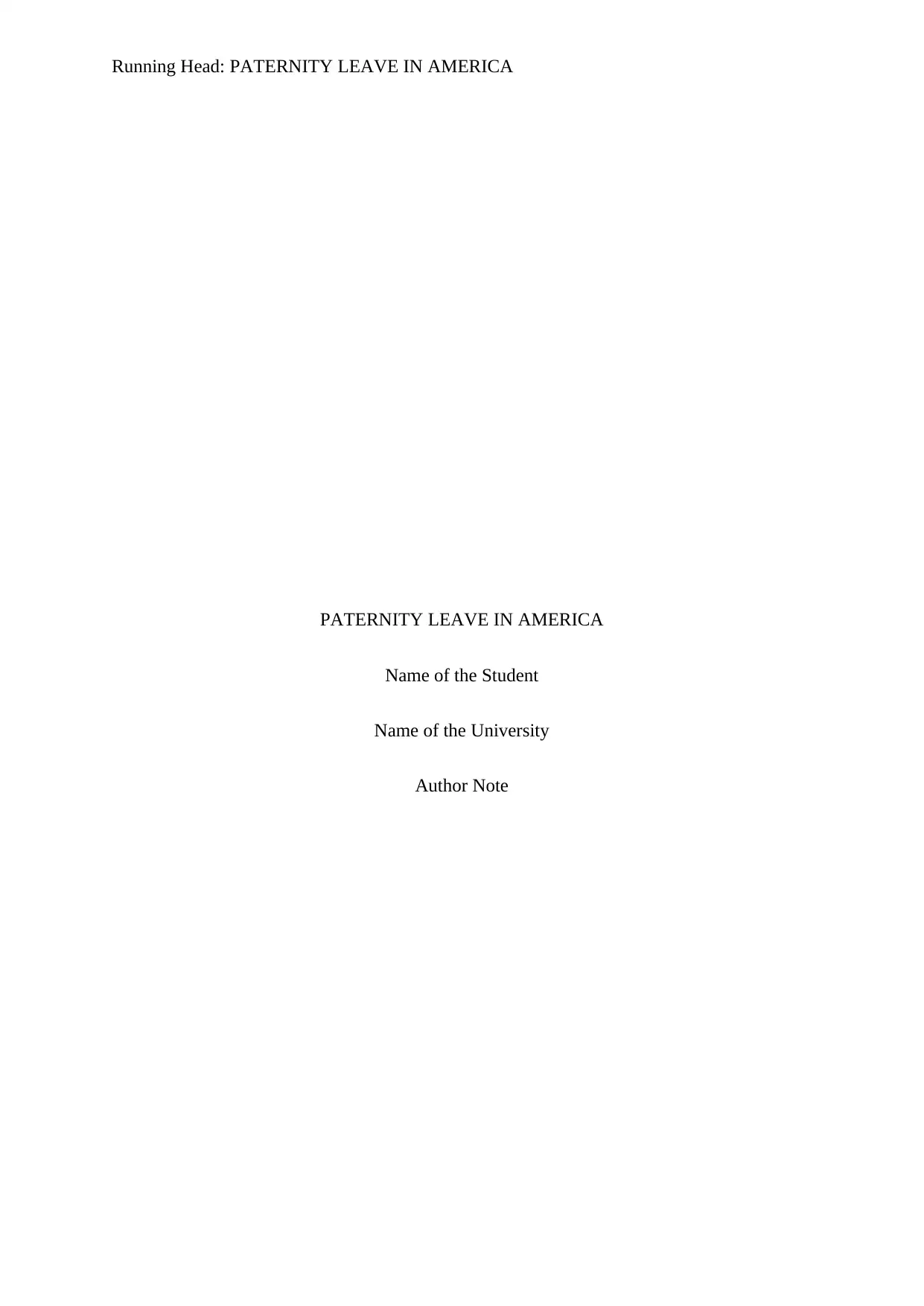
Running Head: PATERNITY LEAVE IN AMERICA
PATERNITY LEAVE IN AMERICA
Name of the Student
Name of the University
Author Note
PATERNITY LEAVE IN AMERICA
Name of the Student
Name of the University
Author Note
Paraphrase This Document
Need a fresh take? Get an instant paraphrase of this document with our AI Paraphraser
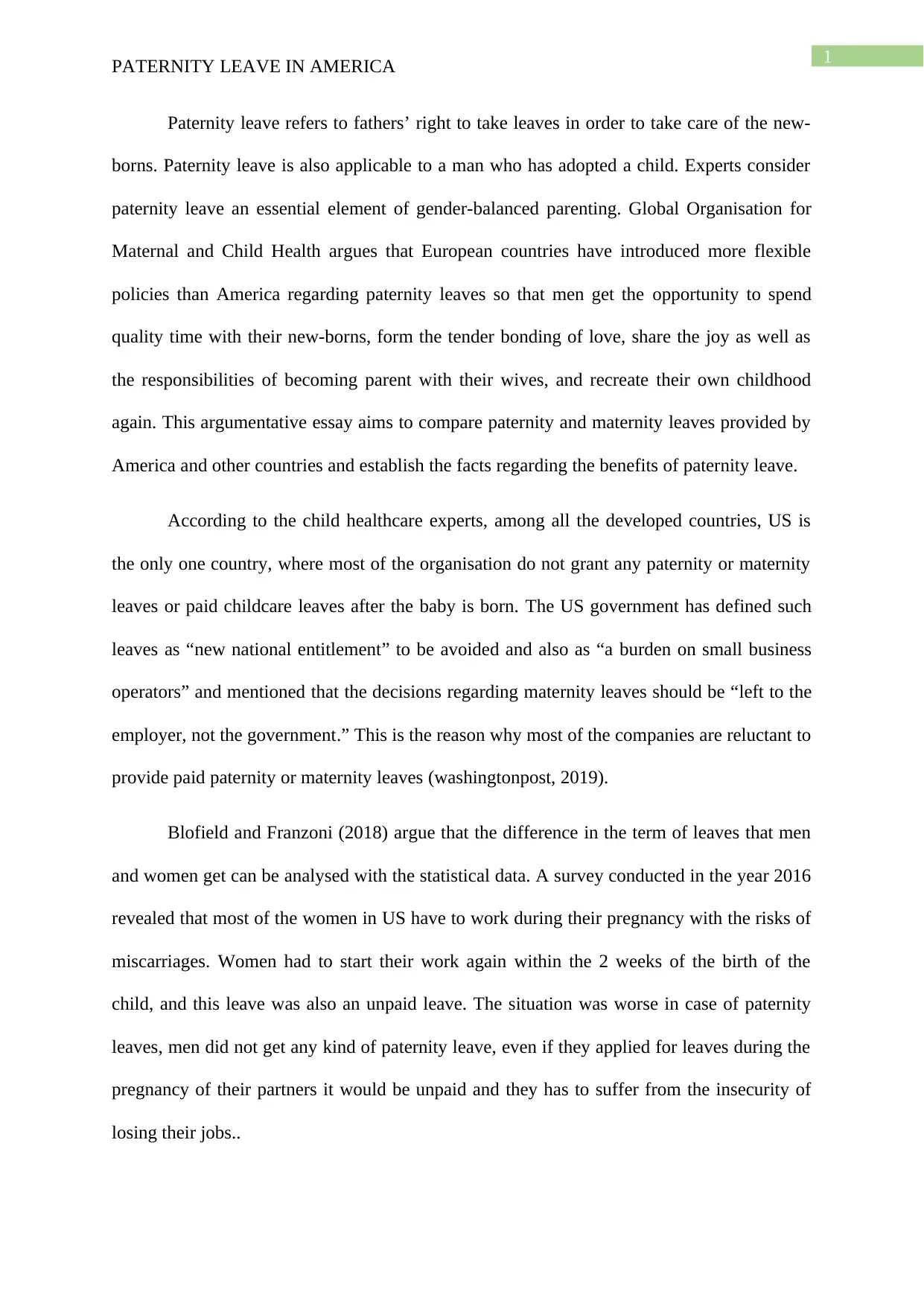
1
PATERNITY LEAVE IN AMERICA
Paternity leave refers to fathers’ right to take leaves in order to take care of the new-
borns. Paternity leave is also applicable to a man who has adopted a child. Experts consider
paternity leave an essential element of gender-balanced parenting. Global Organisation for
Maternal and Child Health argues that European countries have introduced more flexible
policies than America regarding paternity leaves so that men get the opportunity to spend
quality time with their new-borns, form the tender bonding of love, share the joy as well as
the responsibilities of becoming parent with their wives, and recreate their own childhood
again. This argumentative essay aims to compare paternity and maternity leaves provided by
America and other countries and establish the facts regarding the benefits of paternity leave.
According to the child healthcare experts, among all the developed countries, US is
the only one country, where most of the organisation do not grant any paternity or maternity
leaves or paid childcare leaves after the baby is born. The US government has defined such
leaves as “new national entitlement” to be avoided and also as “a burden on small business
operators” and mentioned that the decisions regarding maternity leaves should be “left to the
employer, not the government.” This is the reason why most of the companies are reluctant to
provide paid paternity or maternity leaves (washingtonpost, 2019).
Blofield and Franzoni (2018) argue that the difference in the term of leaves that men
and women get can be analysed with the statistical data. A survey conducted in the year 2016
revealed that most of the women in US have to work during their pregnancy with the risks of
miscarriages. Women had to start their work again within the 2 weeks of the birth of the
child, and this leave was also an unpaid leave. The situation was worse in case of paternity
leaves, men did not get any kind of paternity leave, even if they applied for leaves during the
pregnancy of their partners it would be unpaid and they has to suffer from the insecurity of
losing their jobs..
PATERNITY LEAVE IN AMERICA
Paternity leave refers to fathers’ right to take leaves in order to take care of the new-
borns. Paternity leave is also applicable to a man who has adopted a child. Experts consider
paternity leave an essential element of gender-balanced parenting. Global Organisation for
Maternal and Child Health argues that European countries have introduced more flexible
policies than America regarding paternity leaves so that men get the opportunity to spend
quality time with their new-borns, form the tender bonding of love, share the joy as well as
the responsibilities of becoming parent with their wives, and recreate their own childhood
again. This argumentative essay aims to compare paternity and maternity leaves provided by
America and other countries and establish the facts regarding the benefits of paternity leave.
According to the child healthcare experts, among all the developed countries, US is
the only one country, where most of the organisation do not grant any paternity or maternity
leaves or paid childcare leaves after the baby is born. The US government has defined such
leaves as “new national entitlement” to be avoided and also as “a burden on small business
operators” and mentioned that the decisions regarding maternity leaves should be “left to the
employer, not the government.” This is the reason why most of the companies are reluctant to
provide paid paternity or maternity leaves (washingtonpost, 2019).
Blofield and Franzoni (2018) argue that the difference in the term of leaves that men
and women get can be analysed with the statistical data. A survey conducted in the year 2016
revealed that most of the women in US have to work during their pregnancy with the risks of
miscarriages. Women had to start their work again within the 2 weeks of the birth of the
child, and this leave was also an unpaid leave. The situation was worse in case of paternity
leaves, men did not get any kind of paternity leave, even if they applied for leaves during the
pregnancy of their partners it would be unpaid and they has to suffer from the insecurity of
losing their jobs..
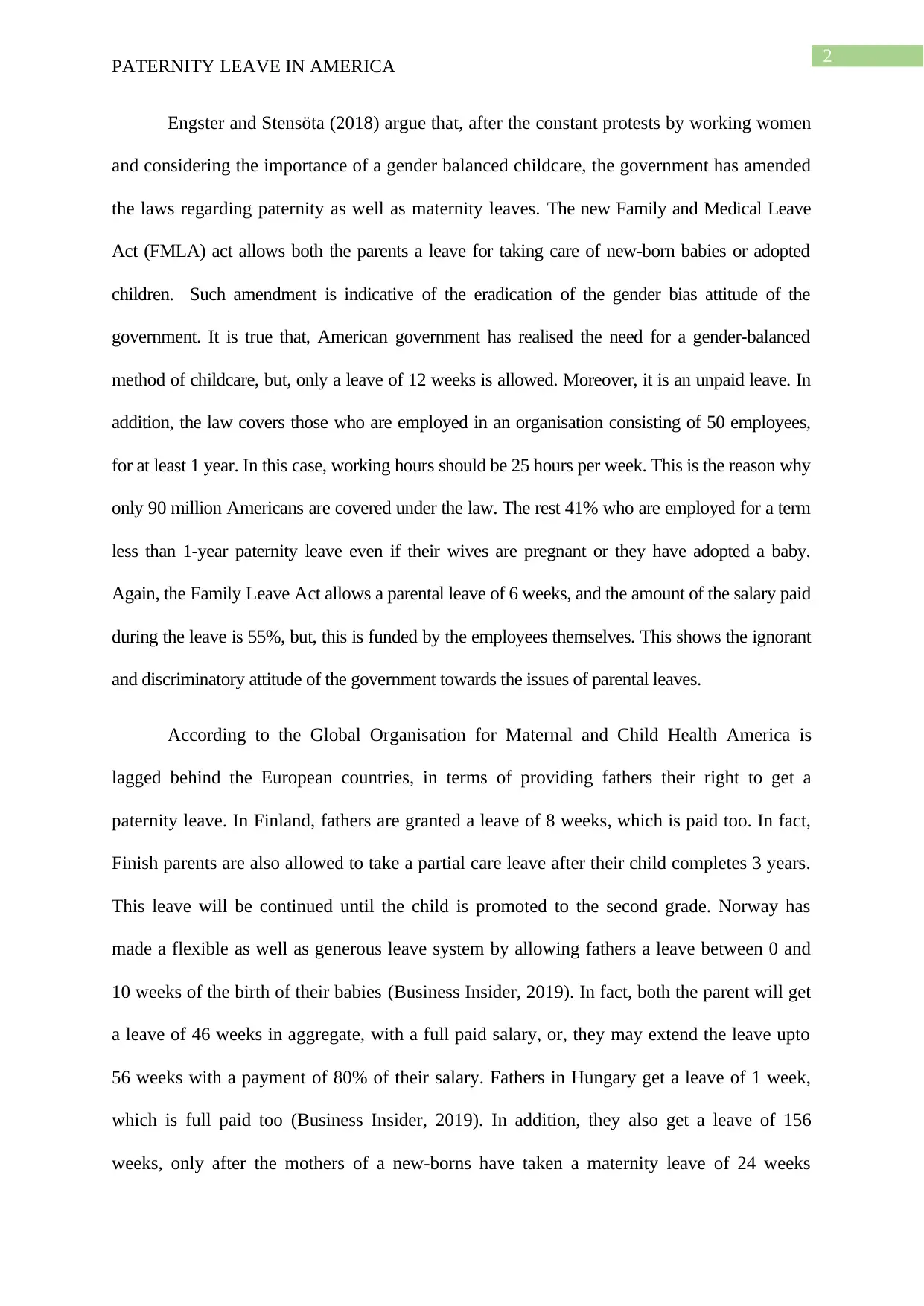
2
PATERNITY LEAVE IN AMERICA
Engster and Stensöta (2018) argue that, after the constant protests by working women
and considering the importance of a gender balanced childcare, the government has amended
the laws regarding paternity as well as maternity leaves. The new Family and Medical Leave
Act (FMLA) act allows both the parents a leave for taking care of new-born babies or adopted
children. Such amendment is indicative of the eradication of the gender bias attitude of the
government. It is true that, American government has realised the need for a gender-balanced
method of childcare, but, only a leave of 12 weeks is allowed. Moreover, it is an unpaid leave. In
addition, the law covers those who are employed in an organisation consisting of 50 employees,
for at least 1 year. In this case, working hours should be 25 hours per week. This is the reason why
only 90 million Americans are covered under the law. The rest 41% who are employed for a term
less than 1-year paternity leave even if their wives are pregnant or they have adopted a baby.
Again, the Family Leave Act allows a parental leave of 6 weeks, and the amount of the salary paid
during the leave is 55%, but, this is funded by the employees themselves. This shows the ignorant
and discriminatory attitude of the government towards the issues of parental leaves.
According to the Global Organisation for Maternal and Child Health America is
lagged behind the European countries, in terms of providing fathers their right to get a
paternity leave. In Finland, fathers are granted a leave of 8 weeks, which is paid too. In fact,
Finish parents are also allowed to take a partial care leave after their child completes 3 years.
This leave will be continued until the child is promoted to the second grade. Norway has
made a flexible as well as generous leave system by allowing fathers a leave between 0 and
10 weeks of the birth of their babies (Business Insider, 2019). In fact, both the parent will get
a leave of 46 weeks in aggregate, with a full paid salary, or, they may extend the leave upto
56 weeks with a payment of 80% of their salary. Fathers in Hungary get a leave of 1 week,
which is full paid too (Business Insider, 2019). In addition, they also get a leave of 156
weeks, only after the mothers of a new-borns have taken a maternity leave of 24 weeks
PATERNITY LEAVE IN AMERICA
Engster and Stensöta (2018) argue that, after the constant protests by working women
and considering the importance of a gender balanced childcare, the government has amended
the laws regarding paternity as well as maternity leaves. The new Family and Medical Leave
Act (FMLA) act allows both the parents a leave for taking care of new-born babies or adopted
children. Such amendment is indicative of the eradication of the gender bias attitude of the
government. It is true that, American government has realised the need for a gender-balanced
method of childcare, but, only a leave of 12 weeks is allowed. Moreover, it is an unpaid leave. In
addition, the law covers those who are employed in an organisation consisting of 50 employees,
for at least 1 year. In this case, working hours should be 25 hours per week. This is the reason why
only 90 million Americans are covered under the law. The rest 41% who are employed for a term
less than 1-year paternity leave even if their wives are pregnant or they have adopted a baby.
Again, the Family Leave Act allows a parental leave of 6 weeks, and the amount of the salary paid
during the leave is 55%, but, this is funded by the employees themselves. This shows the ignorant
and discriminatory attitude of the government towards the issues of parental leaves.
According to the Global Organisation for Maternal and Child Health America is
lagged behind the European countries, in terms of providing fathers their right to get a
paternity leave. In Finland, fathers are granted a leave of 8 weeks, which is paid too. In fact,
Finish parents are also allowed to take a partial care leave after their child completes 3 years.
This leave will be continued until the child is promoted to the second grade. Norway has
made a flexible as well as generous leave system by allowing fathers a leave between 0 and
10 weeks of the birth of their babies (Business Insider, 2019). In fact, both the parent will get
a leave of 46 weeks in aggregate, with a full paid salary, or, they may extend the leave upto
56 weeks with a payment of 80% of their salary. Fathers in Hungary get a leave of 1 week,
which is full paid too (Business Insider, 2019). In addition, they also get a leave of 156
weeks, only after the mothers of a new-borns have taken a maternity leave of 24 weeks
⊘ This is a preview!⊘
Do you want full access?
Subscribe today to unlock all pages.

Trusted by 1+ million students worldwide
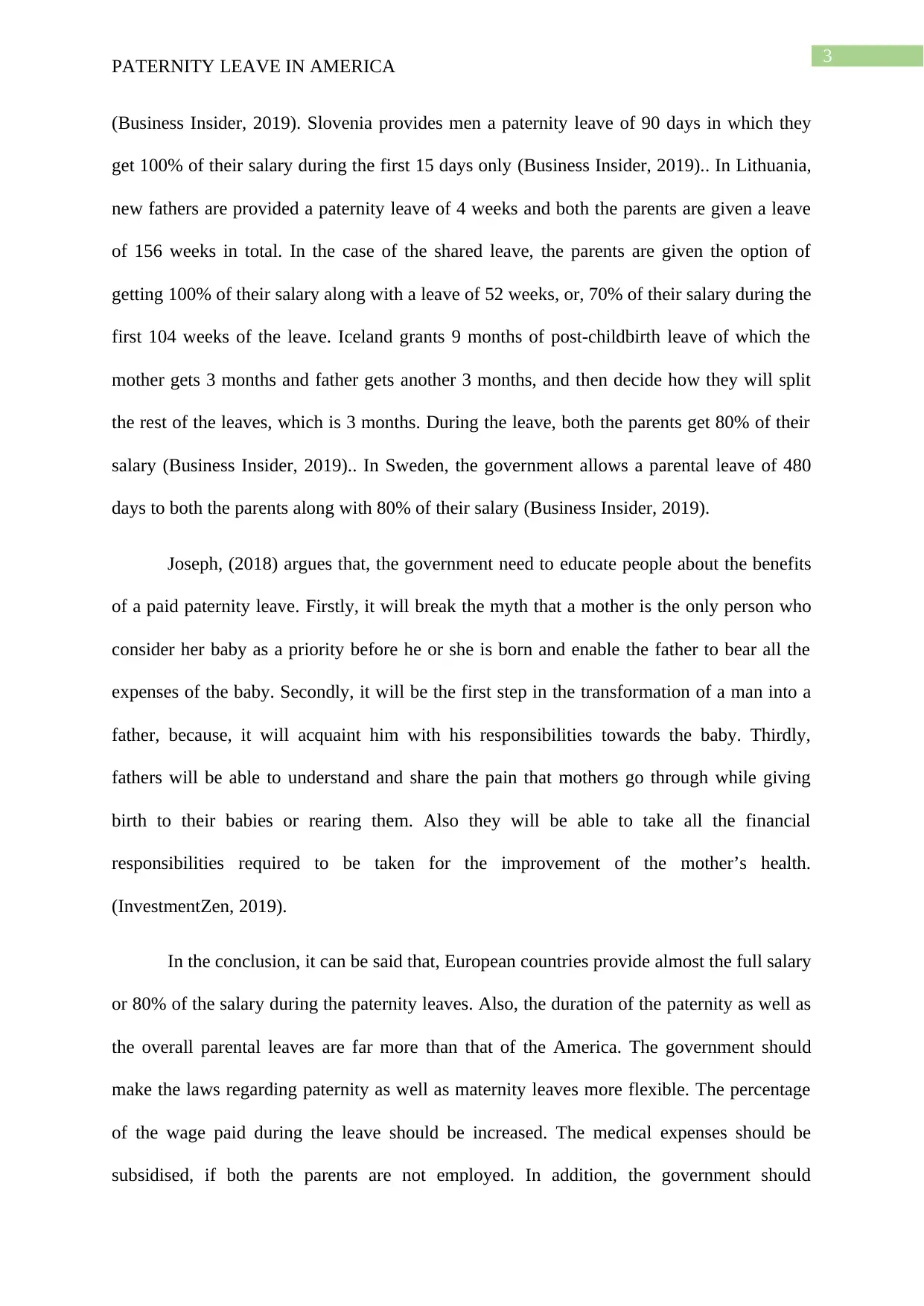
3
PATERNITY LEAVE IN AMERICA
(Business Insider, 2019). Slovenia provides men a paternity leave of 90 days in which they
get 100% of their salary during the first 15 days only (Business Insider, 2019).. In Lithuania,
new fathers are provided a paternity leave of 4 weeks and both the parents are given a leave
of 156 weeks in total. In the case of the shared leave, the parents are given the option of
getting 100% of their salary along with a leave of 52 weeks, or, 70% of their salary during the
first 104 weeks of the leave. Iceland grants 9 months of post-childbirth leave of which the
mother gets 3 months and father gets another 3 months, and then decide how they will split
the rest of the leaves, which is 3 months. During the leave, both the parents get 80% of their
salary (Business Insider, 2019).. In Sweden, the government allows a parental leave of 480
days to both the parents along with 80% of their salary (Business Insider, 2019).
Joseph, (2018) argues that, the government need to educate people about the benefits
of a paid paternity leave. Firstly, it will break the myth that a mother is the only person who
consider her baby as a priority before he or she is born and enable the father to bear all the
expenses of the baby. Secondly, it will be the first step in the transformation of a man into a
father, because, it will acquaint him with his responsibilities towards the baby. Thirdly,
fathers will be able to understand and share the pain that mothers go through while giving
birth to their babies or rearing them. Also they will be able to take all the financial
responsibilities required to be taken for the improvement of the mother’s health.
(InvestmentZen, 2019).
In the conclusion, it can be said that, European countries provide almost the full salary
or 80% of the salary during the paternity leaves. Also, the duration of the paternity as well as
the overall parental leaves are far more than that of the America. The government should
make the laws regarding paternity as well as maternity leaves more flexible. The percentage
of the wage paid during the leave should be increased. The medical expenses should be
subsidised, if both the parents are not employed. In addition, the government should
PATERNITY LEAVE IN AMERICA
(Business Insider, 2019). Slovenia provides men a paternity leave of 90 days in which they
get 100% of their salary during the first 15 days only (Business Insider, 2019).. In Lithuania,
new fathers are provided a paternity leave of 4 weeks and both the parents are given a leave
of 156 weeks in total. In the case of the shared leave, the parents are given the option of
getting 100% of their salary along with a leave of 52 weeks, or, 70% of their salary during the
first 104 weeks of the leave. Iceland grants 9 months of post-childbirth leave of which the
mother gets 3 months and father gets another 3 months, and then decide how they will split
the rest of the leaves, which is 3 months. During the leave, both the parents get 80% of their
salary (Business Insider, 2019).. In Sweden, the government allows a parental leave of 480
days to both the parents along with 80% of their salary (Business Insider, 2019).
Joseph, (2018) argues that, the government need to educate people about the benefits
of a paid paternity leave. Firstly, it will break the myth that a mother is the only person who
consider her baby as a priority before he or she is born and enable the father to bear all the
expenses of the baby. Secondly, it will be the first step in the transformation of a man into a
father, because, it will acquaint him with his responsibilities towards the baby. Thirdly,
fathers will be able to understand and share the pain that mothers go through while giving
birth to their babies or rearing them. Also they will be able to take all the financial
responsibilities required to be taken for the improvement of the mother’s health.
(InvestmentZen, 2019).
In the conclusion, it can be said that, European countries provide almost the full salary
or 80% of the salary during the paternity leaves. Also, the duration of the paternity as well as
the overall parental leaves are far more than that of the America. The government should
make the laws regarding paternity as well as maternity leaves more flexible. The percentage
of the wage paid during the leave should be increased. The medical expenses should be
subsidised, if both the parents are not employed. In addition, the government should
Paraphrase This Document
Need a fresh take? Get an instant paraphrase of this document with our AI Paraphraser
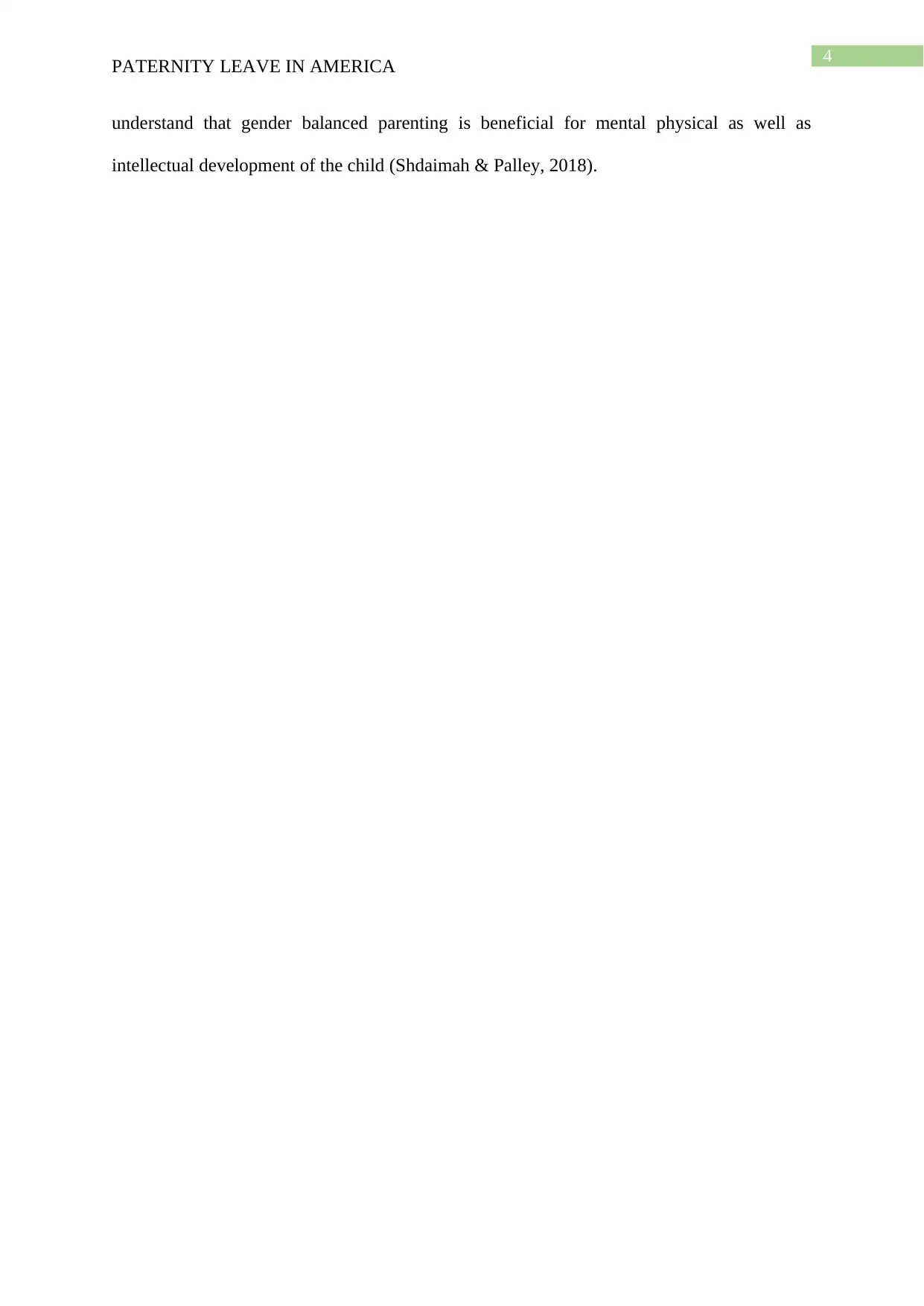
4
PATERNITY LEAVE IN AMERICA
understand that gender balanced parenting is beneficial for mental physical as well as
intellectual development of the child (Shdaimah & Palley, 2018).
PATERNITY LEAVE IN AMERICA
understand that gender balanced parenting is beneficial for mental physical as well as
intellectual development of the child (Shdaimah & Palley, 2018).
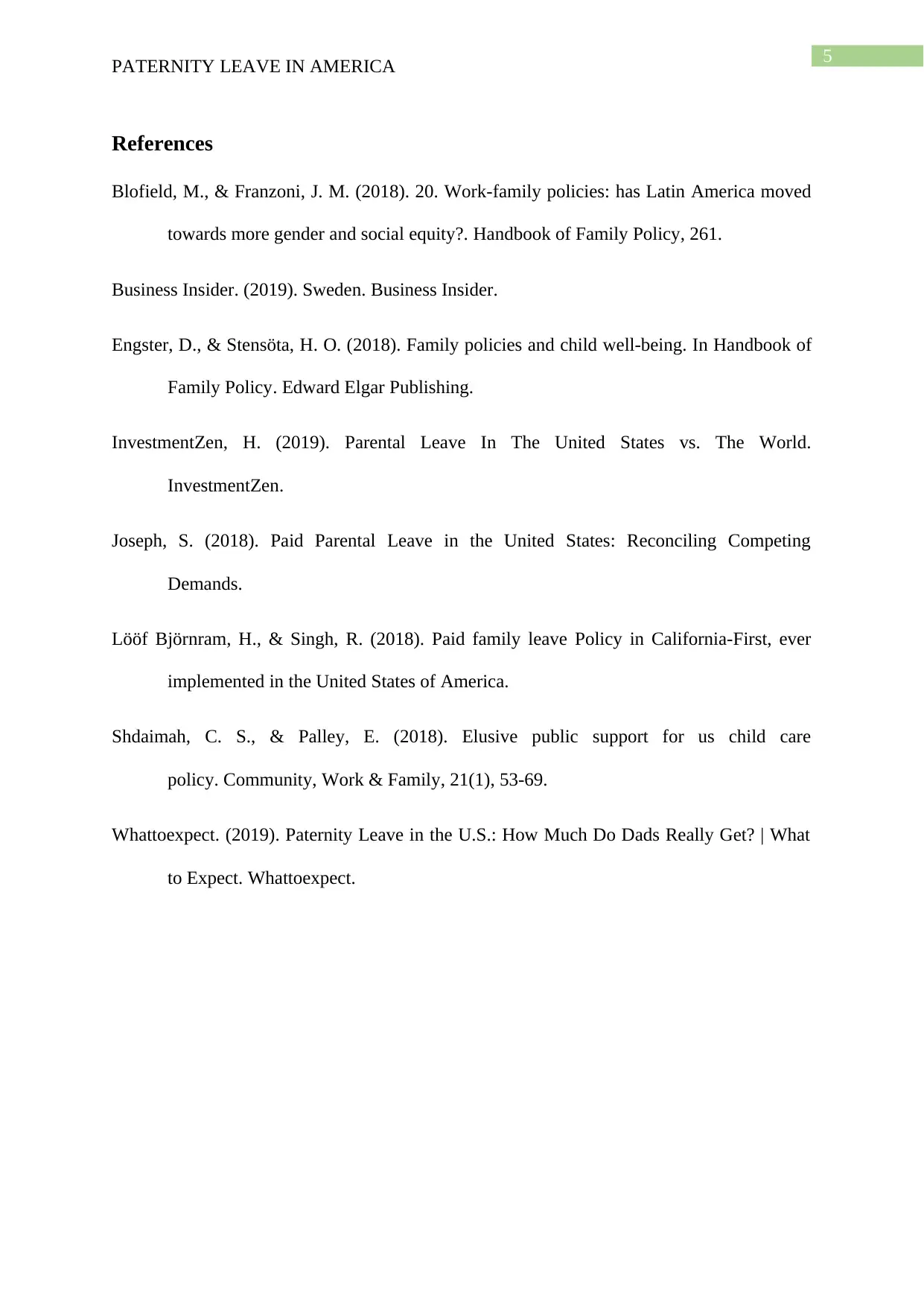
5
PATERNITY LEAVE IN AMERICA
References
Blofield, M., & Franzoni, J. M. (2018). 20. Work-family policies: has Latin America moved
towards more gender and social equity?. Handbook of Family Policy, 261.
Business Insider. (2019). Sweden. Business Insider.
Engster, D., & Stensöta, H. O. (2018). Family policies and child well-being. In Handbook of
Family Policy. Edward Elgar Publishing.
InvestmentZen, H. (2019). Parental Leave In The United States vs. The World.
InvestmentZen.
Joseph, S. (2018). Paid Parental Leave in the United States: Reconciling Competing
Demands.
Lööf Björnram, H., & Singh, R. (2018). Paid family leave Policy in California-First, ever
implemented in the United States of America.
Shdaimah, C. S., & Palley, E. (2018). Elusive public support for us child care
policy. Community, Work & Family, 21(1), 53-69.
Whattoexpect. (2019). Paternity Leave in the U.S.: How Much Do Dads Really Get? | What
to Expect. Whattoexpect.
PATERNITY LEAVE IN AMERICA
References
Blofield, M., & Franzoni, J. M. (2018). 20. Work-family policies: has Latin America moved
towards more gender and social equity?. Handbook of Family Policy, 261.
Business Insider. (2019). Sweden. Business Insider.
Engster, D., & Stensöta, H. O. (2018). Family policies and child well-being. In Handbook of
Family Policy. Edward Elgar Publishing.
InvestmentZen, H. (2019). Parental Leave In The United States vs. The World.
InvestmentZen.
Joseph, S. (2018). Paid Parental Leave in the United States: Reconciling Competing
Demands.
Lööf Björnram, H., & Singh, R. (2018). Paid family leave Policy in California-First, ever
implemented in the United States of America.
Shdaimah, C. S., & Palley, E. (2018). Elusive public support for us child care
policy. Community, Work & Family, 21(1), 53-69.
Whattoexpect. (2019). Paternity Leave in the U.S.: How Much Do Dads Really Get? | What
to Expect. Whattoexpect.
⊘ This is a preview!⊘
Do you want full access?
Subscribe today to unlock all pages.

Trusted by 1+ million students worldwide
1 out of 6
Your All-in-One AI-Powered Toolkit for Academic Success.
+13062052269
info@desklib.com
Available 24*7 on WhatsApp / Email
![[object Object]](/_next/static/media/star-bottom.7253800d.svg)
Unlock your academic potential
Copyright © 2020–2025 A2Z Services. All Rights Reserved. Developed and managed by ZUCOL.


